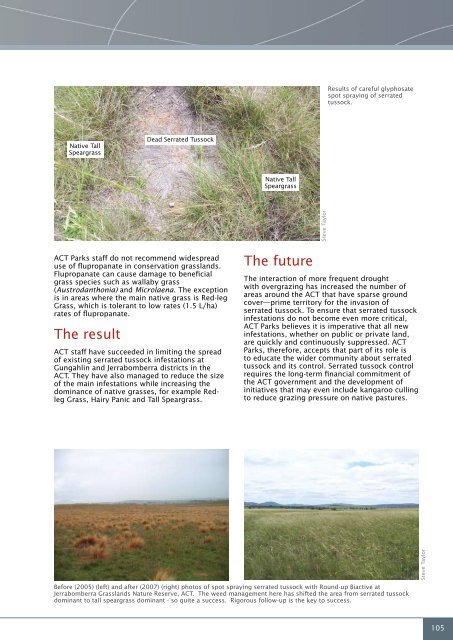Section 5 Case studies - Weeds Australia
Section 5 Case studies - Weeds Australia
Section 5 Case studies - Weeds Australia
You also want an ePaper? Increase the reach of your titles
YUMPU automatically turns print PDFs into web optimized ePapers that Google loves.
Results of careful glyphosate<br />
spot spraying of serrated<br />
tussock.<br />
Native Tall<br />
Speargrass<br />
Dead Serrated Tussock<br />
Native Tall<br />
Speargrass<br />
Steve Taylor<br />
ACT Parks staff do not recommend widespread<br />
use of flupropanate in conservation grasslands.<br />
Flupropanate can cause damage to beneficial<br />
grass species such as wallaby grass<br />
(Austrodanthonia) and Microlaena. The exception<br />
is in areas where the main native grass is Red-leg<br />
Grass, which is tolerant to low rates (1.5 L/ha)<br />
rates of flupropanate.<br />
The result<br />
ACT staff have succeeded in limiting the spread<br />
of existing serrated tussock infestations at<br />
Gungahlin and Jerrabomberra districts in the<br />
ACT. They have also managed to reduce the size<br />
of the main infestations while increasing the<br />
dominance of native grasses, for example Redleg<br />
Grass, Hairy Panic and Tall Speargrass.<br />
The future<br />
The interaction of more frequent drought<br />
with overgrazing has increased the number of<br />
areas around the ACT that have sparse ground<br />
cover—prime territory for the invasion of<br />
serrated tussock. To ensure that serrated tussock<br />
infestations do not become even more critical,<br />
ACT Parks believes it is imperative that all new<br />
infestations, whether on public or private land,<br />
are quickly and continuously suppressed. ACT<br />
Parks, therefore, accepts that part of its role is<br />
to educate the wider community about serrated<br />
tussock and its control. Serrated tussock control<br />
requires the long-term financial commitment of<br />
the ACT government and the development of<br />
initiatives that may even include kangaroo culling<br />
to reduce grazing pressure on native pastures.<br />
Before (2005) (left) and after (2007) (right) photos of spot spraying serrated tussock with Round-up Biactive at<br />
Jerrabomberra Grasslands Nature Reserve, ACT. The weed management here has shifted the area from serrated tussock<br />
dominant to tall speargrass dominant - so quite a success. Rigorous follow-up is the key to success.<br />
Steve Taylor<br />
105

















